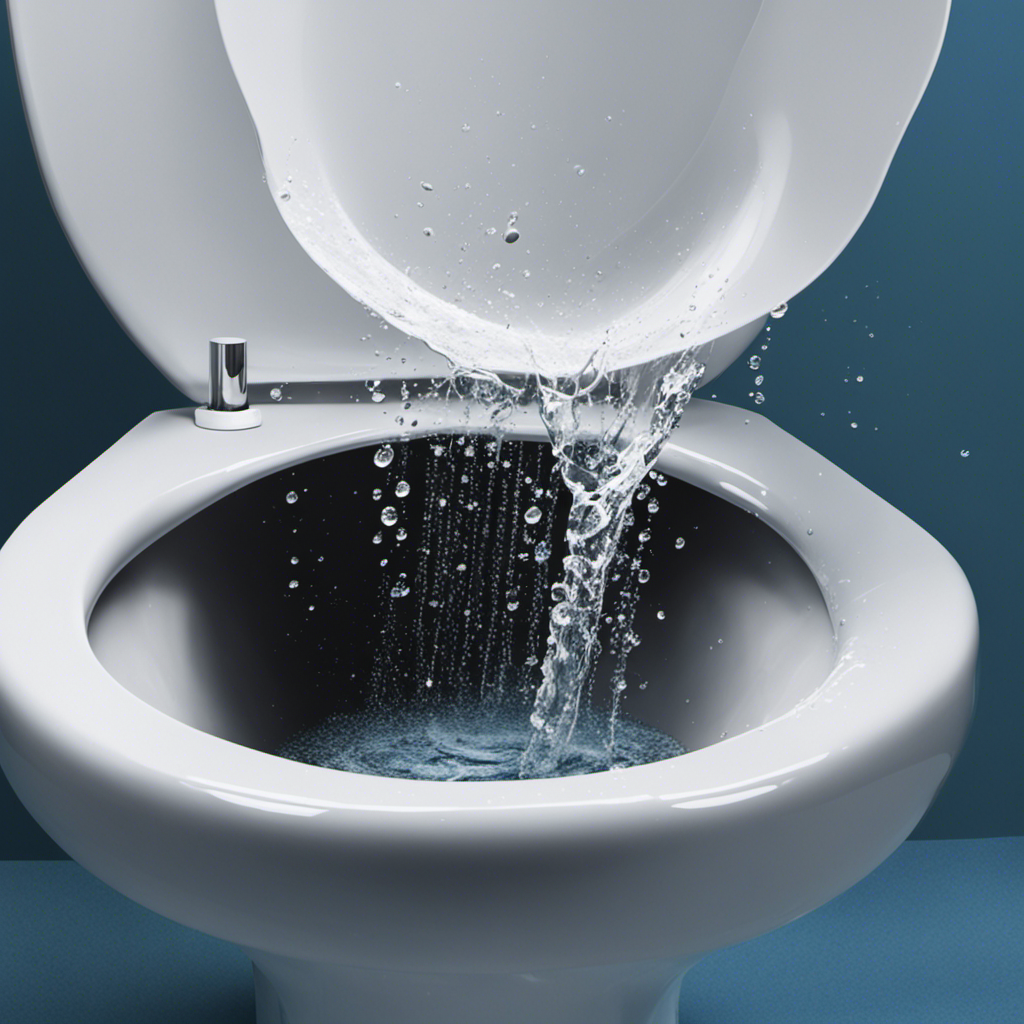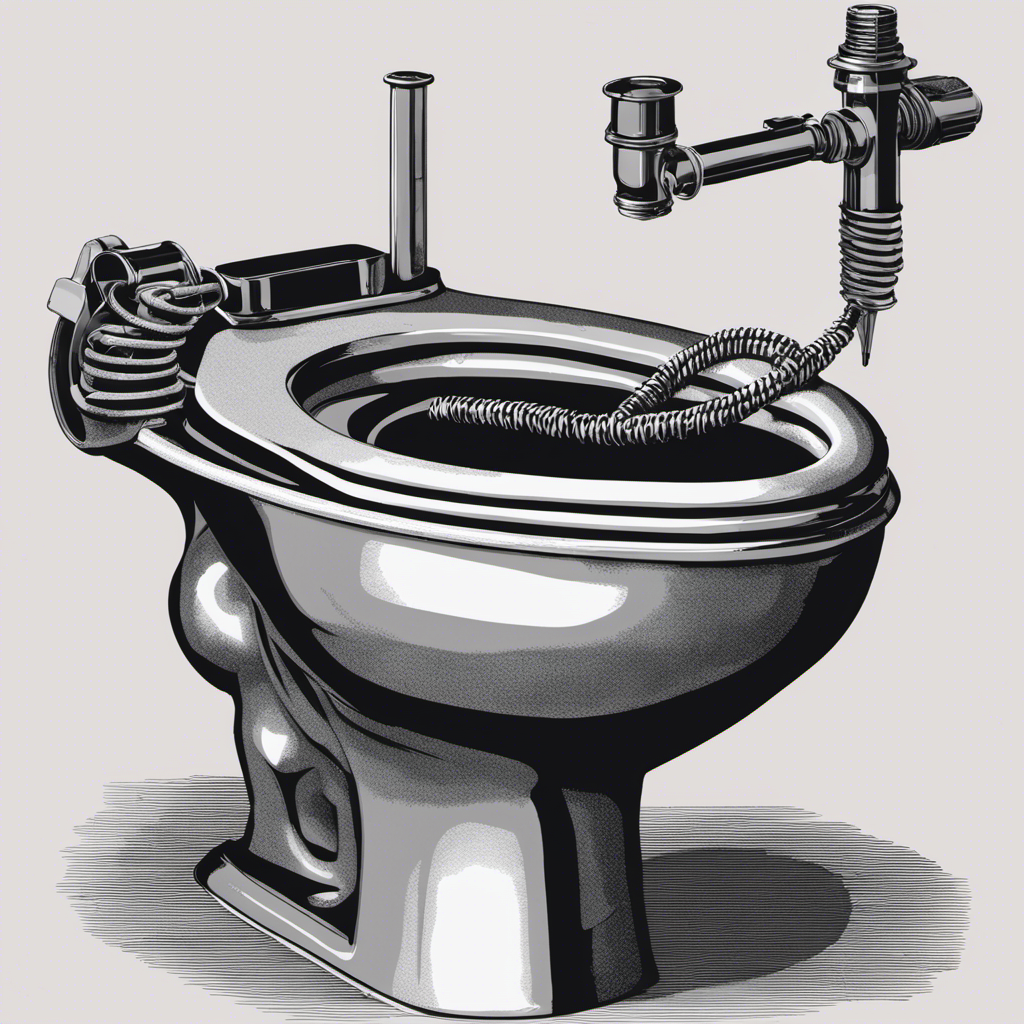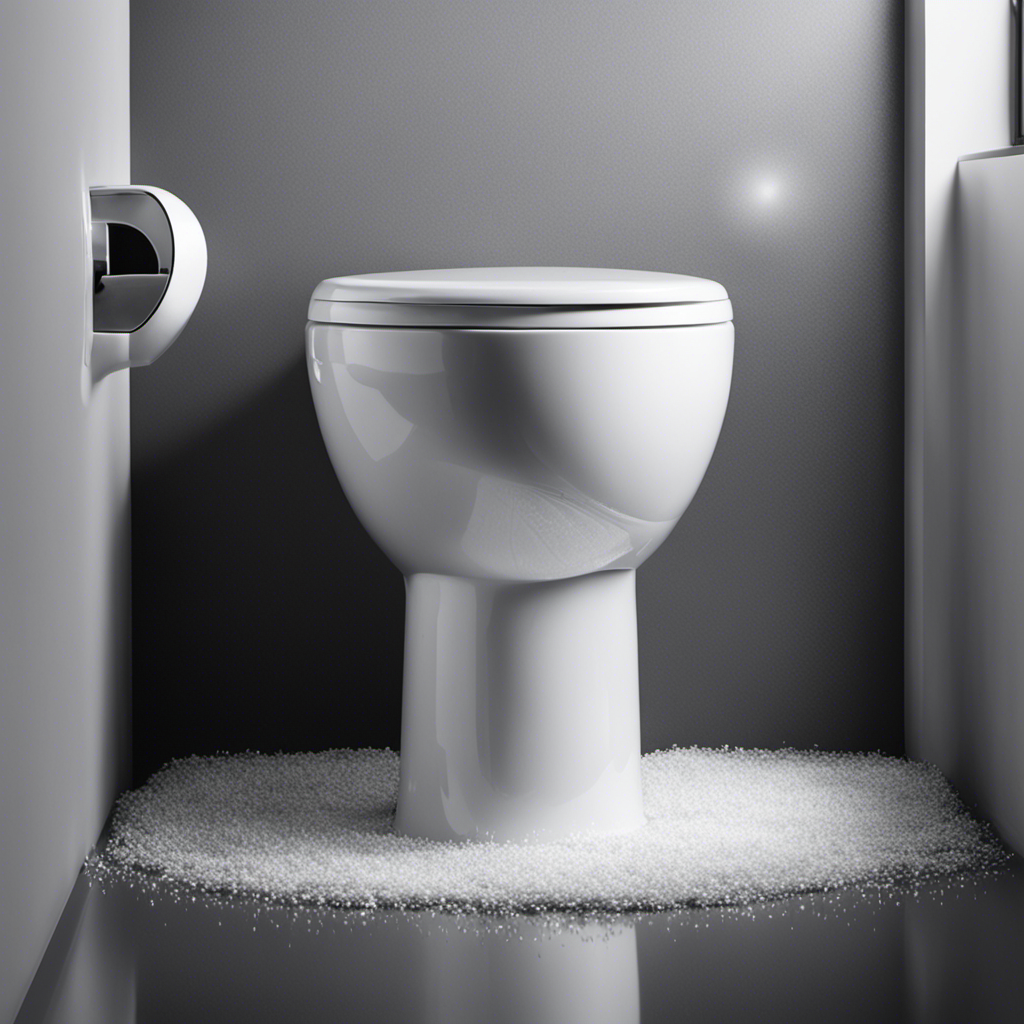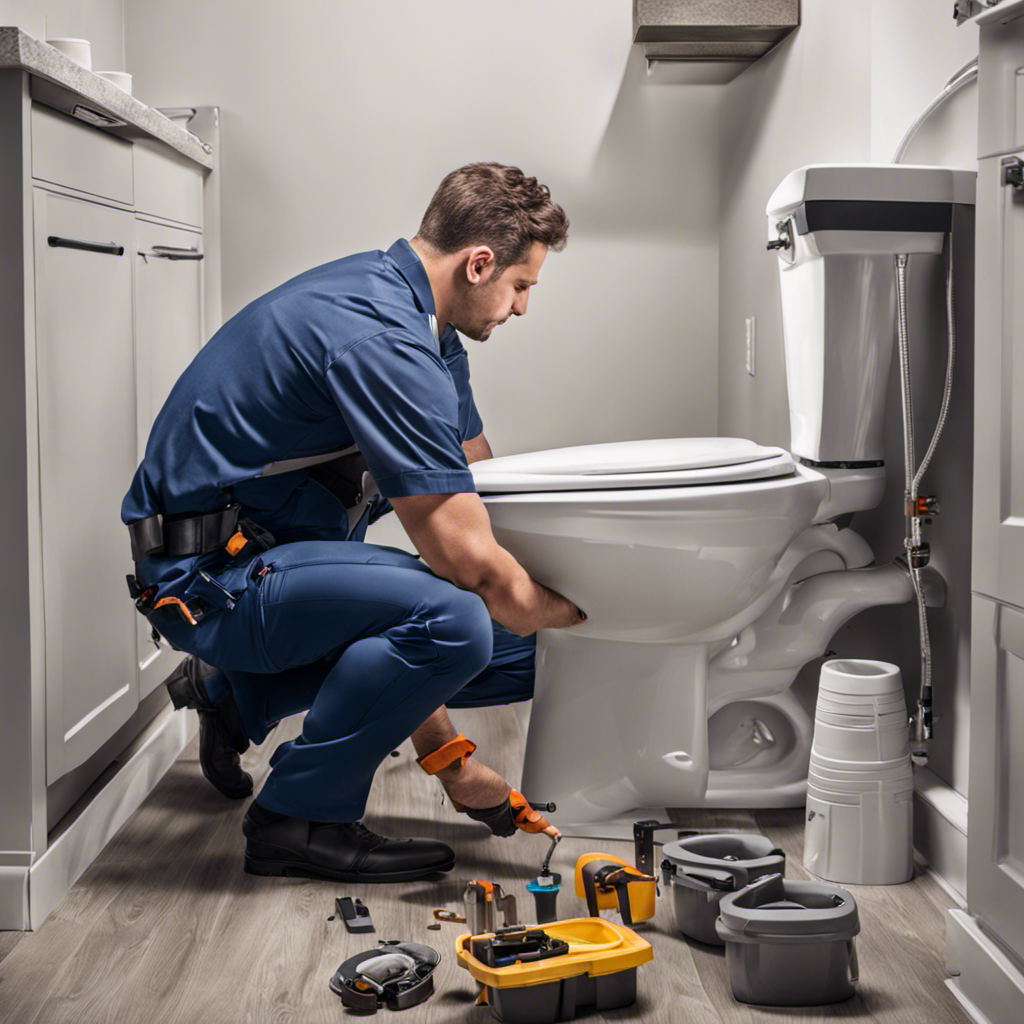Hey there! Did you know that water leaking from under the toilet when flushed is a common plumbing issue? Well, I’ve got some good news for you – I’m here to help you fix it!
In this article, we’ll explore the possible causes of this problem, how to identify the source of the leak, and step-by-step instructions on fixing it. Whether it’s a faulty wax ring seal, a loose toilet base, or even a cracked bowl or tank, I’ve got you covered.
So let’s dive in and get your toilet back in tip-top shape!
Key Takeaways
- Possible causes of water coming from under the toilet when flushed include faulty wax ring, cracked toilet bowl or tank, loose or damaged water supply line, and faulty flush valve.
- To identify the source of the toilet leak, check for wet floor around the toilet, inspect the base of the toilet for cracks or gaps, examine the water supply line and connections for signs of water dripping or pooling, and notice a decrease in water levels in the toilet tank or hear a constant running sound.
- To fix a leaky wax ring seal, shut off the water supply, remove the toilet, replace the wax ring seal, clean the toilet flange, and reinstall the toilet and tighten the bolts.
- Preventive measures for water leaks include regularly inspecting the wax ring, ensuring proper sealing of the wax ring, and hiring a professional for accurate diagnosis and repair.
Possible Causes of Water Leaking From Under the Toilet
One possible cause of water leaking from under your toilet could be a faulty wax ring. The wax ring is a seal that sits between the toilet and the floor drain, preventing water from seeping out. Over time, the wax ring can degrade or become loose, resulting in water leakage.
Other causes of toilet leaks include a cracked toilet bowl or tank, loose or damaged water supply line, or a faulty flush valve.
Troubleshooting toilet leaks involves a systematic approach. Start by inspecting the wax ring for any signs of wear or damage. Tighten any loose bolts or connections and check for cracks in the toilet bowl or tank.
If the issue persists, it may be necessary to call a professional plumber for further diagnosis and repair.
How to Identify the Source of the Toilet Leak
To identify the source of the toilet leak, you can start by checking if the floor around the toilet is wet. This is often the first sign of a leak and shouldn’t be ignored.
Additionally, you can inspect the base of the toilet for any cracks or gaps. Another area to check is the water supply line and the connections. Look for any signs of water dripping or pooling around these areas.
Sometimes, the leak may not be visible, but you may notice a decrease in water levels in the toilet tank or hear a constant running sound. If you suspect a leak but can’t find the source, it’s important to address the issue promptly to prevent further damage.
There are ways to fix a toilet leak without professional help, such as tightening loose connections or replacing faulty parts.
Steps to Fix a Leaky Wax Ring Seal
Check your toilet for any signs of a leak by examining the wax ring seal. It is an essential component that ensures a watertight seal between the toilet and the floor drain. If you notice water pooling around the base of your toilet or a foul odor coming from the bathroom, it is likely that the wax ring seal is broken or damaged.
Here are three steps to fix a leaky wax ring seal:
-
Shut off the water supply: Locate the shut-off valve near the base of the toilet and turn it clockwise until the water flow stops.
-
Remove the toilet: Disconnect the water supply line and unscrew the bolts securing the toilet to the floor. Carefully lift the toilet and set it aside.
-
Replace the wax ring seal: Remove the old wax ring seal and clean the toilet flange. Install a new wax ring seal, ensuring it is centered properly. Reinstall the toilet and tighten the bolts.
Replacing a Faulty Toilet Flange: A Step-by-Step Guide
If you notice a foul odor in your bathroom, it could be a sign that your toilet flange needs to be replaced. Toilet flange replacement is a necessary task to ensure the proper functioning of your toilet and prevent any water leaks or unpleasant smells.
To start the process, turn off the water supply to the toilet and remove the toilet bowl from the flange. Next, remove the old flange by unscrewing it from the floor. Clean the area thoroughly to remove any residue or debris.
Install the new flange by aligning it with the drain pipe and securing it to the floor with screws. Finally, reattach the toilet bowl and turn on the water supply.
Performing a toilet flange installation or replacement may require some technical knowledge, so it’s recommended to consult a professional if you’re unsure.
Fixing a Loose or Damaged Toilet Base
I can help you with repairing toilet base leaks and tightening a loose toilet base. These common issues can lead to water damage and instability in your bathroom.
In this discussion, I’ll provide step-by-step instructions and tips on how to fix these problems efficiently and effectively.
Repairing Toilet Base Leaks
The first step in repairing toilet base leaks is to ensure that the water supply to the toilet is turned off. This is crucial in order to prevent any further water damage.
Once the water supply is shut off, follow these steps to repair the toilet base leaks:
-
Inspect the toilet base: Check for any cracks or gaps around the base of the toilet. These can be potential sources of leaks.
-
Tighten the bolts: Use a wrench to tighten the bolts that secure the toilet to the floor. Loose bolts can cause water to leak from the base.
-
Replace the wax ring: If the toilet base is still leaking after tightening the bolts, it may be necessary to replace the wax ring. This ring sits between the toilet base and the floor, creating a watertight seal.
Regular toilet base maintenance and prompt repairs are essential for preventing water damage in your bathroom. By following these steps, you can effectively address and fix toilet base leaks.
Tightening Loose Toilet Base
To fix a loose toilet base, start by using a wrench to tighten the bolts securing it to the floor. This is a common issue that can cause water leaks and instability in the toilet. By tightening the bolts, you can ensure that the toilet base is securely attached to the floor, preventing any movement or wobbling. Additionally, it is important to seal the toilet base to prevent any water from seeping out. You can use a waterproof sealant or silicone caulk to create a watertight seal between the toilet base and the floor. This will help to prevent any water leaks and keep your bathroom dry and functional.
Here is a table to summarize the steps for tightening toilet bolts and sealing the toilet base:
| Steps | Description |
|---|---|
| Step 1 | Use a wrench to tighten the bolts securing the toilet base to the floor. |
| Step 2 | Check for any movement or wobbling of the toilet base. |
| Step 3 | Apply a waterproof sealant or silicone caulk around the base to create a watertight seal. |
Repairing a Cracked Toilet Bowl or Tank
When it comes to toilet maintenance, one common issue that homeowners may encounter is a cracked toilet bowl or tank. Cracks can lead to water leaks, causing potential damage and inconvenience.
In this discussion, we will explore effective methods for fixing toilet cracks, ways to prevent water leaks, and professional repair options available.
Fixing Toilet Cracks
One way to fix toilet cracks is by applying epoxy resin to the damaged area. This method is effective in repairing and sealing toilet cracks, preventing any leakage or water damage.
Here are three reasons why using epoxy resin is a great solution for fixing toilet cracks:
-
Easy application: Epoxy resin can be easily applied to the cracked area, creating a strong and durable bond that seals the crack effectively.
-
Waterproof seal: Epoxy resin creates a waterproof barrier, ensuring that no water will leak from the cracked area.
-
Long-lasting repair: Once the epoxy resin has cured, it forms a solid and durable surface, providing a long-lasting solution to the cracked toilet. This eliminates the need for frequent repairs or replacements.
Preventing Water Leaks
Make sure you regularly inspect the wax ring and ensure it is properly sealed to prevent any potential leaks.
Toilet maintenance is crucial in preventing water damage. A properly sealed wax ring creates a watertight seal between the toilet and the floor drain. Over time, the wax ring can deteriorate, compromising the seal and causing leaks.
To inspect the wax ring, start by turning off the water supply and flushing the toilet to empty the tank and bowl. Carefully remove the toilet by unscrewing the bolts at the base. Inspect the wax ring for any signs of damage or wear. If necessary, replace the wax ring and reinstall the toilet.
Professional Repair Options
If you’re experiencing a leak, you can contact a professional for repair options. Here are three reasons why hiring a professional for toilet repairs is a wise choice:
-
Expertise: Professionals have the knowledge and experience to accurately diagnose and fix toilet leaks. They understand the complex workings of toilets and can identify the root cause of the problem quickly.
-
Efficiency: Hiring a professional ensures that the repair is done efficiently and effectively. They have the necessary tools and equipment to complete the job in a timely manner, saving you time and hassle.
-
Cost-effective: While DIY toilet repairs may seem like a cheaper option, they can often lead to more expensive repairs in the long run. Professionals know how to fix the issue correctly the first time, preventing further damage and costly repairs down the line.
When it comes to toilet repair costs, hiring a professional may be the smarter choice for a lasting and cost-effective solution.
Preventive Measures to Avoid Water Leaks From Under the Toilet
To prevent water leaks from under the toilet, it’s important to regularly check the condition of the wax ring. This simple maintenance task can help avoid costly water damage to your bathroom floor and surrounding areas. The wax ring is a circular seal that fits between the base of the toilet and the floor drain. Over time, the wax ring can deteriorate or become misaligned, causing water to seep through. To check the condition of the wax ring, simply remove the toilet and inspect the seal. If it appears damaged or worn out, it’s time to replace it. Regularly inspecting and replacing the wax ring as needed is a crucial part of toilet maintenance and water damage prevention.
| Benefits of Regular Wax Ring Inspection | Steps to Inspect the Wax Ring |
|---|---|
| Prevents water leaks from under the toilet | Turn off the water supply |
| Avoids costly water damage | Flush the toilet to drain water |
| Maintains the integrity of your bathroom | Remove the toilet |
| Ensures proper functioning of the toilet | Inspect the wax ring |
| Extends the lifespan of your toilet | Replace the wax ring as needed |
Conclusion
In conclusion, dealing with water leaks from under the toilet can be a frustrating and messy situation. However, by identifying the source of the leak and following the proper steps, you can easily fix the issue.
From replacing a faulty wax ring seal to repairing a cracked toilet bowl or tank, there are solutions available. By taking preventive measures, such as regular maintenance and inspections, you can avoid future water leaks and ensure your toilet remains in good working condition.
Don’t let the water flow disrupt your peace of mind, take action and fix it today.










